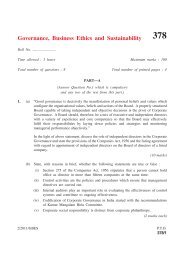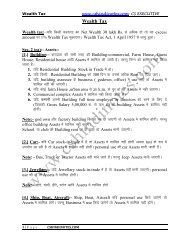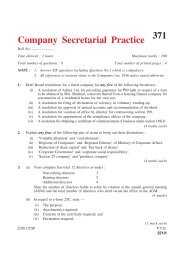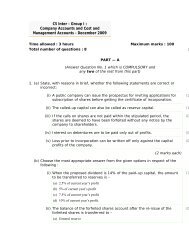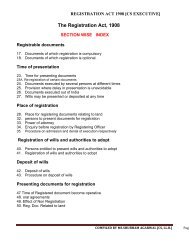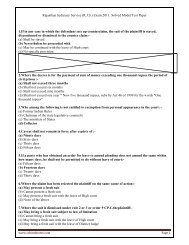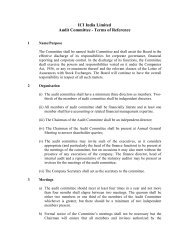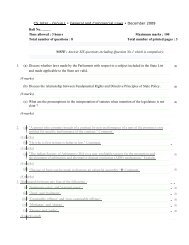SOLVED PAPER GCL JUNE 2011 - CS NOTES
SOLVED PAPER GCL JUNE 2011 - CS NOTES
SOLVED PAPER GCL JUNE 2011 - CS NOTES
You also want an ePaper? Increase the reach of your titles
YUMPU automatically turns print PDFs into web optimized ePapers that Google loves.
<strong>2011</strong> ‐ June [7] (a) Alok was running a school at a certain place. Bimal started another school near<br />
the school of Alok. As a result of this, most of the students of Alok's school left his school and joined<br />
Bimal's school. Due to competition, Alok had to reduce the fees by ` 40 per student per quarter<br />
thereby suffering huge monetary loss. Alok instituted a suit against Bimal in the court for claiming<br />
compensation. Is the suit instituted by Alok maintainable (6 marks)<br />
Ans. In the law of torts there are two types of doctrines under the law of torts – Injuria sine<br />
damnum, and damnum sine injuria.<br />
There are many acts which though harmful are not wrongful and give no right of action to him who<br />
suffers from their effects. Damage so done and suffered is called Damnum Sine Injuria or damage<br />
without injury. Damage without breach of a legal right will not constitute a tort. Such examples<br />
would constitute injury but not damage, as per the rules of torts. They are instances of damage<br />
suffered from justifiable acts. An act or omission committed with lawful justification or excuse will<br />
not be a cause of action though it results in harm to another as a combination in furtherance of<br />
trade interest or lawful user of one’s own premises. In Gloucester Grammar School Master Case, it<br />
had been held that the plaintiff school master had no right to complain of the opening of a new<br />
school. The damage suffered was mere damnum absque/sine injuria or damage without injury.<br />
Hence, in this case, the case is not maintainable, as in opening the school; Bimal is merely exercising<br />
his legal right.<br />
<strong>2011</strong> ‐ June [7] (b) Ashok intentionally and falsely leads Bikram to believe that certain land belongs<br />
to Ashok, and thereby induces Bikram to buy and pay for it. Afterwards, the land becomes the<br />
property of Ashok, and Ashok seeks to set aside the sale on the ground that at the time of the sale<br />
he had no title to the property. Can he be allowed to prove his want of title (5 marks)<br />
Ans. Where a person fraudulently or erroneously represents that he is authorized to transfer certain<br />
immovable property, and professes to transfer such property for consideration, such transfer shall, at<br />
the option of the transferee, operate on any interest which the transferor may acquire in such<br />
property at any time during which the contract of transfer subsists. Nothing in this section shall<br />
impair the right of transferees in good faith for consideration without notice of the existence of the<br />
said option.<br />
Illustration A, a Hindu who has separated from his father B, sells to C three fields, X, Y and Z,<br />
representing that A is authorized to transfer the same. Of these fields Z does not belong to A, it<br />
having been retained by B on the partition; but on B' s dying A as heir obtains Z. C, not having<br />
rescinded the contract of sale, may require A to deliver Z to him.<br />
Moreover, the Doctrine of feeding the grant by estoppels applies on this case, which says that if a<br />
person leads another to believe and to act on any fact intentionally provided by him, he cannot later<br />
on retract his statement and aver.<br />
Hence, in this case, Ashok will not be allowed to prove his want of title. Also, when he once the land<br />
becomes Ashok’s property, he will have to transfer it to Bikram , if Bikram has not cancelled the<br />
contract by then.<br />
<strong>2011</strong> ‐ June [7] (c) A document was executed by several persons at different times. The person in<br />
whose favour such execution was made, presented the document for re‐ registration after expiry of<br />
three months. Can such document be registered and if so, within what period (5 marks)<br />
Ans. Under the Registration Act, 1908, if a document is executed by several persons at different<br />
times, it may be presented for registration within 4 months from date of each execution [section 24].<br />
Moreover, regarding re‐registration, if a person finds that a document has been filed for registration<br />
bya person who is not empowered to do so, he can present the document for re‐registration within<br />
4 months from the date he became aware of the fact that registration of document is invalid<br />
[section 23A].<br />
In this case, the document was executed by several persons at different times. The person in whose<br />
favour such execution was made presented the document for re‐ registration after expiry of three


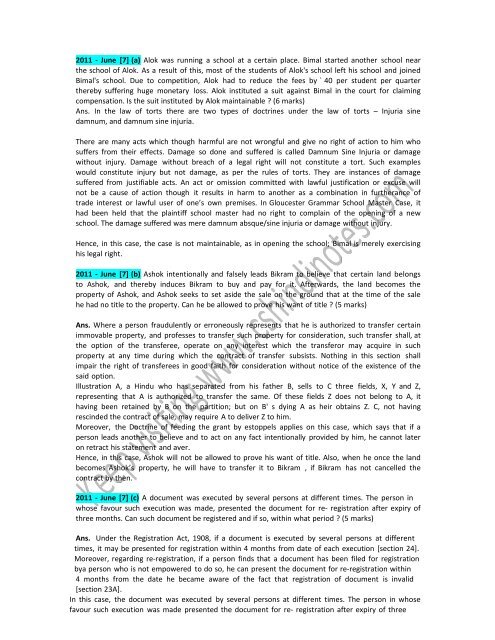
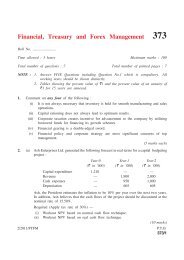

![vf/kfu;e dk vFkZ 'fu.kZ;' [ Interpretation of Statues ] Statue ... - cs notes](https://img.yumpu.com/38855798/1/190x245/vf-kfue-dk-vfkz-fukz-interpretation-of-statues-statue-cs-notes.jpg?quality=85)
